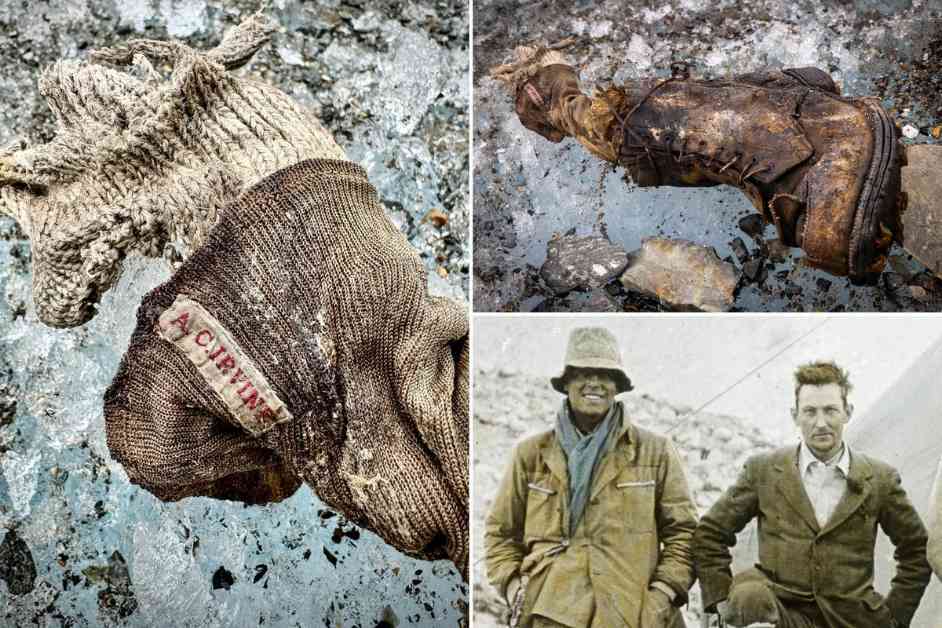The enduring mystery of Mallory and Irvine, the tweed-clad heroes of Everest last seen vanishing into a cloud as mist swept over the Himalayan summit, may finally have been solved 100 years on from the tragedy that so nearly ended in triumph.
Andrew “Sandy” Irvine, the youngest member of the 1924 Mount Everest expedition, disappeared on the upper slopes alongside George Mallory on June 8 that year while attempting to become the first people to climb the world’s highest peak.
With efforts on the coveted summit taking place in the few short years following the First World War, and with Britain having lost the race to the North and South poles in desperate circumstances, the assault on Everest represented efforts to restore the reputation of British exploration – and indeed preserve the prestige of a declining empire.
The mystery of whether the duo reached the top before their death has been debated by climbers and historians for many decades. Now, what appears to be the partial remains of Irvine have finally been uncovered in the biggest breakthrough in the great Everest mystery since Mallory’s frozen corpse was found twenty five years ago.
In the latest development, a sock embroidered with “AC Irvine” and a boot were discovered on the Central Rongbuk Glacier, below the North Face, by a team of mountaineers filming a documentary.
The finding offers the first meaningful insight into the young man’s death since the ill-fated expedition to the 8,849-metre peak – with the Irvine family having volunteered to compare DNA test results with the remains to confirm his identity.
Notably, the sock and boot were found at a lower altitude than Mallory’s remains, which were located by climber Conrad Anker in 1999, and are now in the possession of the China Tibet Mountaineering Association, which is responsible for climbing permits on Everest’s northern side.
Jimmy Chin, a professional mountaineer and director of the 2018 climbing docufilm Free Solo, fronted a National Geographic team who found what is believed to be Irvine’s sock and boot still intact.
Chin said: “Sometimes in life, the greatest discoveries occur when you aren’t even looking. This was a monumental and emotional moment for us and our entire team on the ground, and we just hope this can finally bring peace of mind to his relatives and the climbing world at large.
“It’s the first real evidence of where Sandy ended up. A lot of theories have been put out there.
“When someone disappears and there’s no evidence of what happened to them, it can be really challenging for families. And just having some definitive information of where Sandy might’ve ended up is certainly [helpful], and also a big clue for the climbing community as to what happened,” he said.
In September, several days before they came upon the boot, Chin revealed the team was descending the Central Rongbuk Glacier when they found an artifact that piqued their curiosity. “We discovered an oxygen bottle marked with a date on it that said 1933,” he said. The bottle was marked nine years after Mallory and Irvine had gone missing. The 1933 British Everest expedition was the fourth attempt to climb the mountain and also ended in failure, but members of the 1933 expedition did find an ice axe that belonged to Irvine high on the northeast ridge, though well below where Mallory was found.
The discovery of the 1933 oxygen cylinder made Chin wonder. “If Sandy had fallen down the North Face, his remains or his body could be somewhere near here.” Chin suspected that Irvine’s remains could be close. “Sandy could potentially be a few hundred yards up the glacier from here toward the mountain,” he told National Geographic. In the days that followed, Chin and his crew began taking a circuitous route across the folds and crevasses of the glacier. “It was actually Erich Roepke [filmmaker] who spotted something and was like, ‘Hey, what’s that?’,” said Chin. It was the boot, emerging from the ice. “I think it literally melted out a week before we found it.”
Julie Summers, Irvine’s great niece and biographer, said it is “remarkable” to see the discovery made almost exactly 100 years after their deaths. She was “moved to tears” when she heard that her blood relative’s boot had been found.
“I have lived with this story since I was a seven-year-old when my father told us about the mystery of Uncle Sandy on Everest. The story became more real when climbers found the body of George Mallory in 1999, and I wondered if Sandy’s body would be discovered next.
“When Jimmy told me that he saw the name A.C. Irvine on the label on the sock inside the boot, I found myself moved to tears. It was and will remain an extraordinary and poignant moment.”
“Any expedition to Everest follows in the shadow of Irvine and Mallory,” Chin said. “Sometimes in life the greatest discoveries occur when you aren’t even looking. “This was a monumental and emotional moment for us and our entire team on the ground, and we just hope this can finally bring peace of mind to his relatives and the climbing world at large,” he added.












